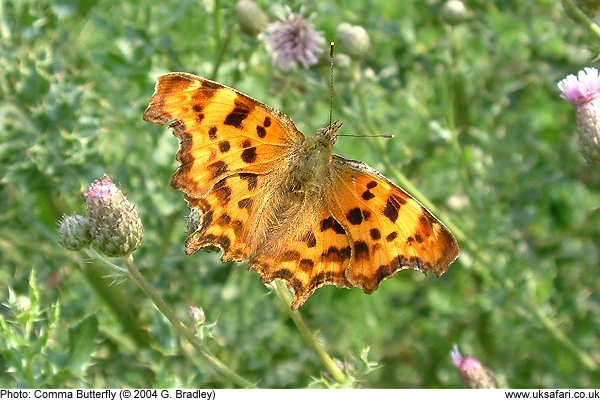 Comma Butterflies
Comma ButterfliesIdentify It > Butterflies Section > Comma Butterflies >

Scientific name: Polygonia c-album
Size: Has a wingspan of around 45mm.
Distribution: Found throughout England, Wales and parts of southern Scotland. Some sightings on the east side of Northern Ireland
Months seen: April to November.
Habitat: Woodlands and gardens.
Food: Nectar.
Special features: Only 100 years ago this ragged looking butterfly was almost extinct in Britain. The reason for its decline is still a mystery, but from 1830 to 1920 sightings in the southern counties of England were reduced to just one or two. It wasn't until around 1930 that numbers started to increase. Today the Comma Butterfly is a familiar sight in southern England and Wales.
The upper surfaces of the wings are an orange-brown colour dotted with black and brown patches. The undersides of the wings are marbled with several shades of brown colour. The undersides also feature a small white 'C' shaped marking, which gives the butterfly its name.
During winter Comma Butterflies hibernate on the lower branches of trees. When they close their wings together they resemble a dead leaf, and can remain perfectly camouflaged throughout the winter.
In earlier years, almost every village had a brew-house, with a field of hops close by, and the hop was the favourite food plant of the Comma caterpillars. The caterpillars are black and white in colour and resemble bird droppings. It was the caterpillars affinity with the hop fields which earned them the nickname of 'hop-cats'. With fewer hop growers around today the caterpillars have switched to feeding on stinging nettles.
 Related Pages
Related Pages

 Popular Pages
Popular PagesAmphibians, Bats, Badgers, Beetles, Birds, Birds of Prey, Bumble Bees, Butterflies, Caterpillars, Climate Change, Deadly Spiders, False Widow Spiders, Frogs, Garden Spiders, Glow-Worms, Hedgehogs, House Spiders, Owls, Spiders, Toads, What's Out Now?
Copyright © 2024 G. Bradley UK Safari. All rights reserved | About Us | Links | Advertise | Contributors